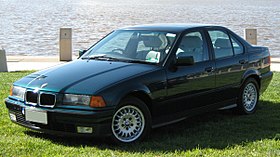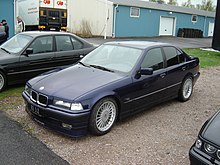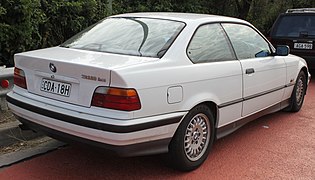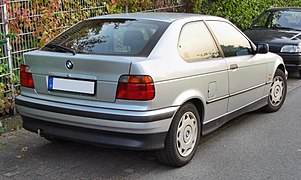auto.wikisort.org - Automobile
The third generation of the BMW 3 Series range of compact executive cars is designated under the model code E36, and was produced by the German automaker BMW from 1990 to 2000. The initial models were of the four-door sedan body style, followed by the coupe, convertible, wagon ("Touring"), hatchback ("Compact"), and the rare four-door convertible Baur TC4 in later years.
| BMW 3 Series (E36) | |
|---|---|
 | |
| Overview | |
| Manufacturer | BMW |
| Production | 1990–2000 |
| Assembly |
|
| Designer | Claus Luthe, Pinky Lai, Boyke Boyer |
| Body and chassis | |
| Class | Compact executive car (D) |
| Body style |
|
| Layout | Front-engine, rear-wheel-drive |
| Related | |
| Powertrain | |
| Engine | |
| Transmission | |
| Dimensions | |
| Wheelbase | 2,700 mm (106.3 in) |
| Length | 4,433 mm (174.5 in)[3] |
| Width | 1,710 mm (67.3 in)[3] |
| Height | 1,366–1,390 mm (53.8–54.7 in)[3] |
| Curb weight | 1,315–1,395 kg (2,899–3,075 lb)[3] |
| Chronology | |
| Predecessor | BMW 3 Series (E30) |
| Successor | BMW 3 Series (E46) |
The E36 was the first 3 Series to be offered in a hatchback body style. It was also the first 3 Series to be available with a six-speed manual transmission (in the 1996 M3), a five-speed automatic transmission, and a four-cylinder diesel engine. The multi-link rear suspension was also a significant upgrade as compared to the previous generations of the 3 Series. All-wheel drive was not available for the E36, unlike the previous (E30) and successive (E46) generations.
The E36 was named in Car and Driver magazine's 10Best list for every year it was on sale.[4]
Following the introduction of its successor, the E46 3 Series in 1998, the E36 began to be phased out and was eventually replaced in 1999.
Development and launch
Development of the E36 began in 1981[5] and the exterior design was heavily influenced by aerodynamics, specifically the overall wedge shape, headlight covers and smaller wing mirrors.[6] The lead designers were Pinky Lai[7] and Boyke Boyer.[8][9]
The production version of the E36 was launched in October 1990, with press release in November and market launch in early 1991.[10][11]
Body styles
The body styles of the range are:
- 4-door sedan, produced from 1990 to 1998.[12]
- 2-door coupé, produced from 1990 to 1999.[13]
- 2-door convertible, produced from 1993 to 1999.[14] A 4-door Baur "Top Cabriolet" conversion was also available.
- 5-door wagon (marketed as "Touring"), produced from 1994 to 1999.[15]
- 3-door hatchback (see BMW 3 Series Compact), produced from 1994 to 2000.[16][17]
- E36 sedan
- E36 coupe
- E36 convertible
- E36 Baur
- E36 Touring
- E36 Compact
Equipment

Safety equipment available included a driver's airbag, passenger airbag (from 1993 production) and side impact airbags in later models,[18] ABS braking and stability control ("ASC +T").[19] Electronic climate control was also available on the E36.
Engines
Petrol
The four-cylinder petrol engines used in the E36 range were initially engines carried over from the previous generation 3 Series: the BMW M40 SOHC engine and the BMW M42 DOHC engine. In 1993, the M40 was replaced by the BMW M43 SOHC engine and the M42 was replaced in 1996 by the BMW M44 DOHC engine.
For the six-cylinder models, the E36 was launched with the then-new BMW M50 DOHC petrol engine. In late 1992 the M50TU versions added single-VANOS (variable valve timing), which increased torque (peak power was unchanged). In 1995, the BMW M52 engine replaced the M50TU, resulting in the 328i model replacing the 325i and the addition of a new mid-range 323i model (powered by a 2.5 litre version of the M52).
In 1992, the 3.0 L BMW S50 engine debuted in the E36 M3. In 1995, its capacity was increased to 3.2 L.[20]
| Model | Years | Engine | Power | Torque |
|---|---|---|---|---|
| 316i | 1990–1994 | M40B16 4-cylinder | 73 kW (100 hp) at 5,500 rpm | 141 N⋅m (104 lb⋅ft) at 4,250 rpm |
| 1993–1999 | M43B16 4-cylinder | 75 kW (102 hp) at 5,500 rpm | 150 N⋅m (111 lb⋅ft) at 3,900 rpm | |
| 318i | 1990–1993* | M40B18 4-cylinder | 83 kW (113 hp) at 5,500 rpm | 162 N⋅m (119 lb⋅ft) at 4,250 rpm |
| 1993–1998 | M43B18 4-cylinder | 85 kW (115 hp) at 5,500 rpm | 168 N⋅m (124 lb⋅ft) at 3,900 rpm | |
| 318is | 1992–1995 | M42B18 4-cylinder | 103 kW (140 hp) at 6,000 rpm | 175 N⋅m (129 lb⋅ft) at 4,500 rpm |
| 1996–1998 | M44B19 4-cylinder | 181 N⋅m (133 lb⋅ft) at 4,300 rpm | ||
| 320i | 1991–1993 | M50B20 6-cylinder | 110 kW (150 hp) at 5,900 rpm | 190 N⋅m (140 lb⋅ft) at 4,700 rpm |
| 1993–1998 | M52B20 6-cylinder | 190 N⋅m (140 lb⋅ft) at 4,200 rpm | ||
| 323i | 1995–1998 | M52B25 6-cylinder | 125 kW (170 hp) at 5,500 rpm[21] | 245 N⋅m (181 lb⋅ft) at 3,950 rpm |
| 325i | 1991–1992 | M50B25 6-cylinder | 141 kW (192 hp) at 5,900 rpm | 245 N⋅m (181 lb⋅ft) at 4,700 rpm |
| 1993–1995 | M50B25TU 6-cylinder | 245 N⋅m (181 lb⋅ft) at 4,200 rpm | ||
| 328i | 1995–1998 | M52B28 6-cylinder | 142 kW (193 hp) at 5,500 rpm | 280 N⋅m (207 lb⋅ft) at 3,950 rpm |
| M3 (Euro spec) | 1992–1995 | S50B30 6-cylinder | 210 kW (286 hp) at 7,000 rpm | 320 N⋅m (236 lb⋅ft) at 3,600 rpm |
| 1995–1998 | S50B32 6-cylinder | 236 kW (321 hp) at 7,400 rpm | 350 N⋅m (258 lb⋅ft) at 3,250 rpm | |
| M3 (U.S. spec) | 1995 | S50B30US 6-cylinder | 179 kW (240 hp) at 6,000 rpm | 305 N⋅m (225 lb⋅ft) at 4,250 rpm |
| 1996–1999 | S52B32 6-cylinder | 320 N⋅m (236 lb⋅ft) at 3,800 rpm |
Diesel
| Model | Years | Engine | Power | Torque |
|---|---|---|---|---|
| 318tds | 1994–2000 | M41D17 4-cylinder | 66 kW (90 hp) at 4,400 rpm | 190 N⋅m (140 lb⋅ft) at 1,900 rpm |
| 325td | 1991–1996 | M51D25UL 6-cylinder | 85 kW (115 hp) at 4,400 rpm | 222 N⋅m (164 lb⋅ft) at 2,000 rpm |
| 1996–1998 | M51D25TUUL 6-cylinder | 85 kW (115 hp) at 4,800 rpm | 230 N⋅m (170 lb⋅ft) at 2,000 rpm | |
| 325tds | 1993–1996 | M51D25OL 6-cylinder | 105 kW (143 hp) at 4,800 rpm | 260 N⋅m (192 lb⋅ft) at 2,200 rpm |
| 1996–1998 | M51D25TUOL 6-cylinder | 105 kW (143 hp) at 4,600 rpm | 280 N⋅m (207 lb⋅ft) at 2,200 rpm |
Initially, the turbocharged straight-six BMW M51 engine was used in the E36 325td model. In 1993, the 325tds model was released, which added an intercooler to the M51. In 1994, the 318tds model was introduced, powered by the four-cylinder BMW M41 turbocharged and intercooled engine. Diesel engines were only available in sedan, touring and compact body styles. The coupe and convertible only had petrol engines.
Drivetrain
The E36 was produced with the following transmissions:
- 5-speed manual (1994-1999 M3)
- 6-speed manual (1996-1999 M3- except for the United States)
- 4-speed automatic
- 5-speed automatic
All models are rear-wheel drive since the E36 was not produced with all-wheel drive (unlike its predecessor and successor).
Suspension
The sedan, coupé, convertible and Touring models use the "Z-axle" multilink suspension in the rear, which was introduced in the BMW Z1 roadster.
The hatchback ("Compact") models use a rear semi-trailing arm suspension based on the older E30 3 Series design. This was done in order to save space due to the truncated rear end of the hatchback.
M3 model

The E36 M3 was launched in 1992 and was powered by the BMW S50 and BMW S52 straight-six engines rather than the four-cylinder units used in the E30. Unlike the predecessor, it was no longer a homologation special and was not developed expressly with competition in mind. It was produced in coupé, sedan, and convertible body styles, making it the first M-car with four doors.
Alpina models

The Alpina B6 2.8, B3 3.0, B3 3.2, B8 4.0 and B8 4.6 models were based on the E36.[22] The B3 and B6 models were powered by straight-six engines, while the B8 models were powered by V8 engines.[23]
E36/5 Compact

The 3 Series Compact range of three-door hatchback models was introduced in 1993, based on a shortened version of the E36 platform. The model code for the hatchback body style is "E36/5" and the model range consisted of 316i, 316g, 318ti, 323ti, and 318tds.
Z3 Roadster/Coupe

A modified version of the E36 platform was used for the 1996-2002 Z3 roadster (model code E36/7) and coupé (model code E36/8).
North American model range
The North American model range consisted of the models listed below. The 318i models were powered by the BMW M42 engine until 1995, and later the BMW M44 engine which was used in the 318is model sold in other countries.
Coupe:
- 318is (1992–1997) - Canada only for 1999 model year
- 323is (1998–1999)
- 325is (1992–1995)
- 328is (1996–1999)
- M3 (1994–1999) - Canada only for the 1994 model year, the US only for 1995 and 1996 model years
Convertible:
- 318i (1994–1997)
- 323i (1998–1999)
- 325i (1994-1995)
- 328i (1996–1999)
- M3 (1998–1999) - US only
Hatchback:
- 318ti (1995–1999)
Sedan:
- 318i (1992–1998) - Canada 1993-1998
- 320i (1993–1995) - Canada only
- 325i (1992–1995)
- 328i (1996–1998)
- M3 (1997–1998)
European model range
The European model range had more variety than the North American and included diesel engines and the station wagon "Touring" body styles. The European market range had more low-range models than the North American, for example, the 316i and 318i had 8-valve SOHC engines. The M3 was also more expensive and had more horsepower than the North American version.
Sedan:
- 316i (1990-1998)
- 318i (1990-1998)
- 318is (1993-1998)
- 320i (1990-1998)
- 323i (1995-1998)
- 325i (1990-1995)
- 328i (1995-1998)
- M3 3.0 (1994-1995)
- M3 3.2 (1995-1997)
- 318tds (1994-1998)
- 325td (1991-1998)
- 325tds (1993-1998)
Coupe:
- 316i (1993-1999)
- 318is (1991-1999)
- 320i (1991-1998)
- 323i (1995-1999)
- 325i (1990-1995)
- 328i (1994-1999)
- M3 3.0 (1992-1995)
- M3 3.2 (1995-1998)
Convertible:
- 318i (1993-1999)
- 320i (1992-1999)
- 323i (1995-1999)
- 325i (1992-1995)
- 328i (1994-1999)
- M3 3.0 (1993-1995)
- M3 3.2 (1995-1999)
Touring:
- 316i (1996-1999)
- 318i (1995-1999)
- 320i (1994-1999)
- 323i (1995-1999)
- 328i (1994-1999)
- 318tds (1994-1999)
- 325tds (1994-1999)
Compact:
- 316i (1993-2000)
- 318ti (1994-2000)
- 323ti (1997-2000)
- 318tds (1994-2000)
- 316g (1995-2000)
Production
The E36 was produced in Munich, Germany; Regensburg, Germany; Rosslyn, South Africa; and Spartanburg County, South Carolina, United States.
Local assembly of complete knock-down (CKD) kits was used for cars sold in Uruguay[24] (until 1991), Egypt, Mexico, and Thailand.[25][26][27] The E36 was also built as CKD kits in the Philippines starting from 1994 up until 1997, where production halted due to the 1997 Asian financial crisis.
Motorsports
Joachim Winkelhock competed in the British Touring Car Championship with the 318i and 320i from 1993 to 1995, winning the title in 1993. In the same year, Johnny Cecotto won the German ADAC GT Cup driving an E36 M3.[28] Cecotto won the Super Tourenwagen Cup for BMW in 1994 and 1998, Winkelhock in 1998.
Geoff Brabham and his younger brother David Brabham won the 1997 AMP Bathurst 1000 at the Mount Panorama Circuit in Bathurst, Australia driving a Super Touring BMW 320i for BMW Motorsport Australia.
The 1998 24 Hours Nürburgring was won by diesel for the first time - a BMW E36 320d, aided by its diesel engine requiring fewer fuel stops than rivals.[29][30]
References
- Herdianto, Radityo (30 July 2019). "BMW Seri 3 di Indonesia, Mobil Ikonik yang Punya Masalah Mengerikan di Masa Lalu". GridOto (in Indonesian). Retrieved 21 September 2019.
- Automology (28 June 2018). "Cars Made in the Colombia :), Really?". Retrieved 30 August 2021.
- "The BMW 3 Series Coupés" (PDF). BMW. 1996. Retrieved 19 February 2019.
- "1998 10Best Cars - 10Best Cars". January 1998. Retrieved 6 January 2017.
- "3 Series - E36 (1990 - 1999)". www.bmwheaven.com. Retrieved 21 December 2017.
- "BMW 3 Series history. The third generation (E36)". www.youtube.com. Retrieved 21 December 2017.[dead YouTube link]
- "Interview with automotive designer Pinky Lai". www.designboom.com. 19 January 2016. Retrieved 3 January 2017.
- "BMW car designers throughout history". www.bmwism.com. Archived from the original on 18 October 2012. Retrieved 3 January 2017.
- Caspers, Markus (2017). Designing Motion: Automotive Designers 1890 to 1990. Birkhäuser. p. 79. ISBN 9783035607840. Retrieved 18 June 2018.
- "Lifestyle-Laster für die linke Spur: Tradition: 30 Jahre BMW 3er Touring". Die Welt. 4 September 2017.
- "1975 The history of the BMW 3 Series". www.topspeed.com. 17 April 2006.
- "BMW 3 Series Sedan (E36)". bmw-grouparchiv.de. Retrieved 17 September 2019.
- "BMW 3 Series Coupe (E36)". bmw-grouparchiv.de. Retrieved 17 September 2019.
- "BMW 3 Series Convertible (E36)". bmw-grouparchiv.de. Retrieved 17 September 2019.
- "BMW 3 Series touring (E36)". bmw-grouparchiv.de. Retrieved 17 September 2019.
- "BMW 3 Series compact (E36)". bmw-grouparchiv.de. Retrieved 17 September 2019.
- "3'E36 Compact 318i model selection". www.realoem.com. Retrieved 1 April 2017.
- "1992-98 BMW 325i/328i/323i". 29 May 2014.
- "Used BMW 318i review: 1991-1998". www.carsguide.com.au. Retrieved 7 April 2019.
- "FAQ E36 M3 3.0". www.bmwmregistry.com. Retrieved 7 April 2019.
- Cobb, James G. (12 July 1998). "BEHIND THE WHEEL/BMW 323is; Last Hurrahs for a Star Performer". The New York Times. ISSN 0362-4331. Retrieved 31 October 2016.
- "3-series [E36]". www.alpina-archive.com. Retrieved 7 April 2019.
- "BMW 3 Series E36". www.alpina-automobiles.com. Retrieved 7 April 2019.
- "Uruguay". e12.de. Retrieved 15 May 2019.
- Jacobs, A. J. (2015). The New Domestic Automakers in the United States and Canada: History, Impacts, and Prospects. Lexington Books. p. 259. ISBN 9780739188262. Retrieved 24 December 2017.
- "BAMC Profile". www.bag-eg.com. Archived from the original on 22 August 2010.
- "SKD-Standort Mexiko". bmw-grouparchiv.de. Retrieved 11 May 2019.
- "DriverDatabase". www.driverdb.com.
- "BMW World - Nürburgring 24 Hours". www.usautoparts.net. Archived from the original on 11 April 2011.
- "BMW motorsport press release". www.bmwsport.net. Archived from the original on 23 July 2011.
На других языках
[de] BMW E36
Die Baureihe E36 ist die dritte 3er-Reihe des Automobilherstellers BMW. Sie wurde im August 1990 als Nachfolger der Baureihe E30 vorgestellt und als Limousine bis Februar 1998 gebaut. Mit der Technik des E36 wurden auch die BMW-Modelle Compact und Z3 gebaut. Ab Februar 1998 wurde der E36 dann kontinuierlich durch das Nachfolgemodell E46 abgelöst. Im September 2000 wurde der Compact eingestellt, der Z3 folgte im Dezember 2002. Insgesamt wurden 2.745.773 BMW E36 gebaut, ausgenommen Z3.[2]- [en] BMW 3 Series (E36)
[es] BMW E36
La carrocería E36 fue la base para el Serie 3 entre 1991 hasta el año 1999. Sucesor del E30 y sustituido por el E46 desde 1999, sin embargo debido a que los coupes y convertibles todavía estaban siendo desarrollados, esta carrocería se siguió produciendo en el año 1999. EL M3 fue producido en el mercado europeo desde 1993 hasta 1999, en Estados Unidos fue diferente ya que entró a este mercado en 1995.[fr] BMW e36
La gamme E36 est la troisième génération de la Série 3 du constructeur automobile BMW. Elle a été introduite en août 1990 en tant que successeur de la gamme E30 et construite en tant que berline jusqu'en février 1998. Les modèles BMW Compact et Z3 ont également été construits avec la technologie de l'E36. À partir de février 1998, l'E36 a ensuite été remplacée par le modèle successeur, l'E46. En septembre 2000, la Compact a été abandonnée, la Z3 a été abandonnée en décembre 2002. Au total, 2 745 773 BMW E36 ont été construites, si l’on exclus la Z3[1].[it] BMW E36
La sigla BMW E36 identifica la terza generazione della Serie 3, un'autovettura di fascia medio-alta prodotta dal 1990 al 2000 dalla casa automobilistica tedesca BMW.[ru] BMW E36
BMW 3-й серии (E36) — третье поколение легковых автомобилей 3-й серии немецкого автоконцерна BMW, выпускавшееся с 1990 по 2000 год. Модели этого поколения стали больше, получили элегантный обтекаемый кузов и изначально создавались как четырёхдверные, в отличие от в основном двухдверных автомобилей второго поколения.Другой контент может иметь иную лицензию. Перед использованием материалов сайта WikiSort.org внимательно изучите правила лицензирования конкретных элементов наполнения сайта.
WikiSort.org - проект по пересортировке и дополнению контента Википедии





